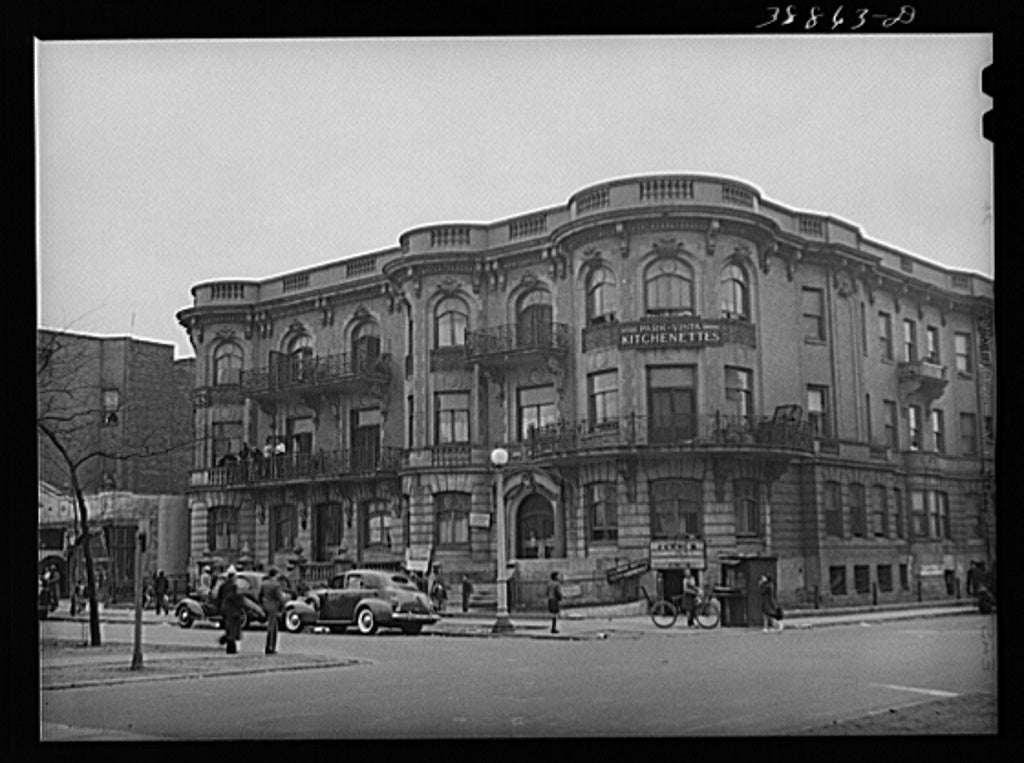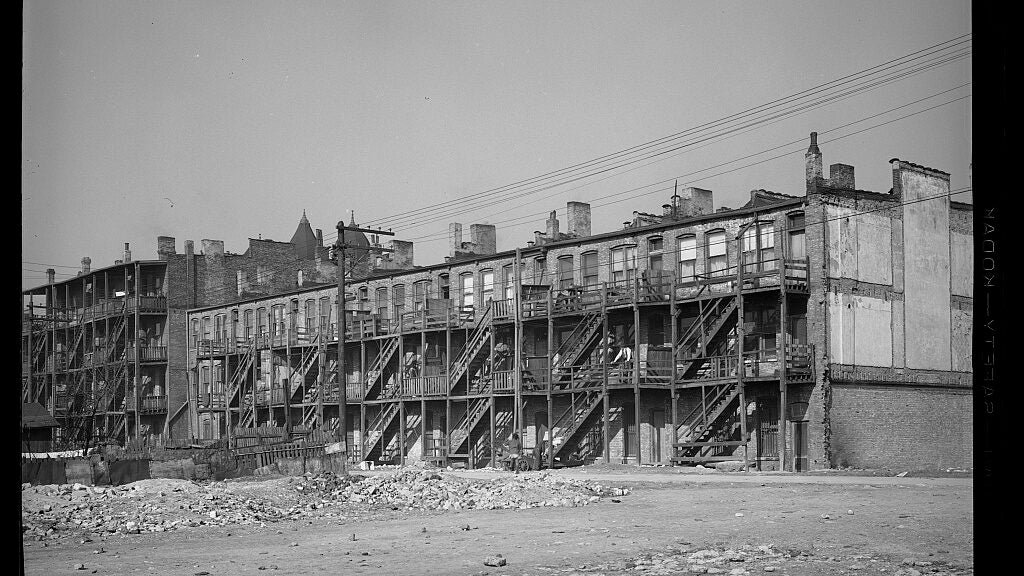Professor Amani Morrison Conducting New Research on the Kitchenettes of Great Migration-Era Chicago
Amani Morrison, Ph.D., an assistant professor in the Department of English, is bringing attention to a crucial part of Black history: the significance of the kitchenette apartment building in mid-twentieth century Chicago. In addition to writing a first-of-its-kind book about kitchenettes during this time period, Morrison has started a digital humanities project with Georgetown students.
“My hope is that I’m doing justice to the place, space, time and subjects around the study of Black Chicago kitchenettes and have opened the door for . . . new lines of inquiry [in]to the rich story that already exists [about] Black Chicago and the 20th century,” Morrison says.
An Academic in the Archives
Morrison began teaching at the university in the fall of 2020. An affiliate faculty member with the Department of African American Studies, Morrison’s research spans a variety of interdisciplinary topics including race and space studies, 20th century African American literature, performance studies, urban humanities and the digital humanities.
“Topics like race require us to bring together various questions that are best answered by an interdisciplinary approach,” Morrison says.
Morrison is currently working on Kitchenette Building: Race, Home Space, and Modernity in Great Migration Chicago, a first of its kind cultural history of Chicago’s mid-century kitchenette apartments, that was born out of her dissertation project.

“Kitchenette apartment buildings, often in disrepair, contained apartments subdivided into ‘kitchenette’ units that were equipped with hot plates, separated by thin beaverboard walls and serviced by communal bathrooms,” explains Morrison. “These units, disproportionately located on Chicago’s South Side and inhabited by Black residents, were often converted illegally and rented out at exorbitant rates by neglectful, absentee landlords.”
An academic with wide-ranging interests, Morrison said picking a single topic for her dissertation proved challenging, but she eventually found that she kept returning to literary texts produced in the 20th century during the Great Migration. While completing an archival fellowship with the Mellon Foundation-supported Black Metropolis Research Consortium, Morrison noticed that there was a gap in the historical records she was analyzing and chose to fill it as her dissertation.
Morrison’s work expands on existing Great Migration literature by diving deeper on the city of Chicago and the physical space of kitchenette buildings.
The kitchenette is featured in many famous pieces of Black literature such as Lorraine Hainsberry’s A Raisin the Sun, Frank London Brown’s Trumbull Park, Richard Wright’s Native Son and Gwendolyn Brooks’ only novel Maud Martha. Brooks also wrote about the kitchenette in her book of poems A Street in Bronzeville.
“You can’t really read African American literature at the time without encountering the kitchenette,” Morrison says. “I realized I didn’t have a good idea of what a kitchenette was and I kept finding snatches of it, passing mentions that suggested that they were bad without a more in-depth description. I thought to myself ‘I don’t know if there is enough archival data for me to write about kitchenettes in Chicago, but I feel like this book needs to exist because it’s so resonant in so many aspects of African American cultural expression of the period.’”
In the early 20th century, the Great Migration resulted in a mass influx of people into cities like Chicago. However, because the Great Migration coincided with the Great Depression there was a significant cutback in new housing construction, and many people were left without a place to live.
“The kitchenette was not only a landing point for migrants, but for people who had lived in Chicago prior to the start of the Great Migration,” Morrison explains. “Because there were not as many residences, whole buildings were converted to smaller units like kitchenettes. These became a part of the Black experience during that time in part because kitchenettes were disproportionately located on the South Side, which was a predominantly Black community.”

During the Great Migration, white society and government entities were invested in residential segregation and achieved it through the rise in use of restrictive covenants and redlining. As more and more people came into the city, Black residents had fewer places to live, and increasingly large numbers of the Black community had to live in converted housing or kitchenettes. Ultimately, this led to stigmatization of the kitchenette.
“In these neighborhoods landlords often wouldn’t pay to have the trash picked up, or there were higher instances of disease because so many people were staying together in tight quarters, so these communities became associated with illness, neglect and uncleanliness,” Morrison says. “The South Side was plagued by the ills that came with overcrowding and the kitchenette became the poster child for the slum.”
Later, public housing became a “beacon of hope” for sanitary, clean and new housing that was precipitated by the kitchenette. Today, Chicago remains a segregated city due in part to housing policies during the Great Migration and Great Depression.
“The government programs that enabled white buyers to move into the suburbs, establish them, and build wealth through homeownership were denied to Black homeowners,” says Morrison. “We see an establishment of generational wealth during the time period of the kitchenette that Black individuals did not have access to in addition to the normalization of placement of different groups of people in different parts of the city that still persists today as a legacy of the entrenchment during the mid-twentieth century.”
Keeping Up with Kitchenettes
In addition to writing her book, Morrison has started a digital humanities project since she began working at Georgetown in the hopes of reaching a wider audience.
“Academic writing isn’t always the best way to convey a story, so I have been developing this digital humanities project as another way for audiences to look at the data,” Morrison explains.
With the help of undergraduate students, Morrison is creating an organizational system for a larger body of the archival documents she has accrued since she began her research and extracting references to the kitchenette from them.
“Going through an archival document to find references to the kitchenette is in some ways like a scavenger hunt because the documents rarely say outright ‘this was a kitchenette,’” Morrison says. “We have been looking at slum clearance documents, documentary photography, housing court documents and language around urban renewal to get a sense of how expansive the use of the kitchenette was.”
After the Archive
This fall, Morrison is teaching a new course called Literature in the Archive, which emerged out of the professor’s own experience (and inspiration by the likes of Toni Morrison and Saidiya Hartman) of employing literature to address vast gaps in archival references and using the archive to ground literary study.
She is also completing a grant proposal for the Mellon Foundation on a collaborative project on creative placemaking, Black ecologies and Black spatial futures. Morrison hopes to engage individuals from across the Georgetown community including in various humanities disciplines, the Law School, the Racial Justice Institute and the School of Foreign Service as well as from Consortium universities.
-by Shelby Roller (G’19) and Hayden Frye (C’17)
